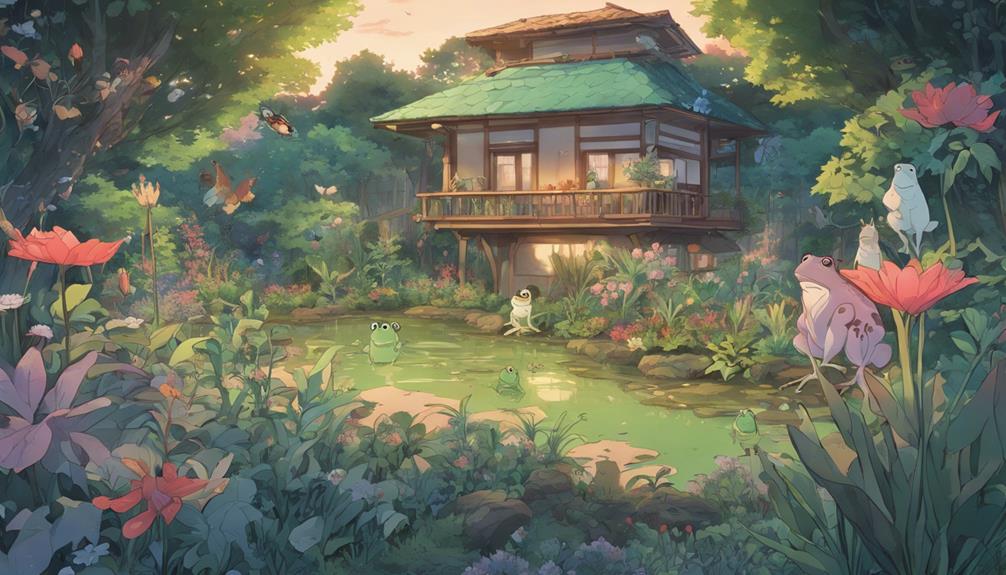Integrating frogs into your garden offers a natural, effective way to control pests. These amphibians consume a vast array of insects, including caterpillars and slugs, devouring over 10,000 pests in a single season. By attracting species like American Green Tree Frogs or Bullfrogs, you can markedly reduce the need for chemical pesticides.
Creating a frog-friendly habitat involves providing natural water sources, safe shelters, and maintaining a chemical-free environment. This approach not only benefits your garden by reducing pests but also promotes a healthy, less polluted ecosystem.
As you establish these conditions, you’ll invite a balanced ecosystem, naturally curbing pest populations and enhancing biodiversity. Continue reading to learn how specific frog species can target different pests, offering tailored pest control solutions for your garden.
Frogs In Your Garden
- Frogs naturally reduce garden pests, lessening the need for chemical pesticides.
- Creating frog-friendly habitats, like ponds, attracts these beneficial amphibians.
- Different frog species, such as American Green Tree and Bullfrogs, target various garden pests.
- A single frog can consume over 10,000 insects in a season, aiding in pest control.
- Maintaining a chemical-free environment is crucial for frog health and effectiveness in pest management.
Why Frogs Benefit Gardens
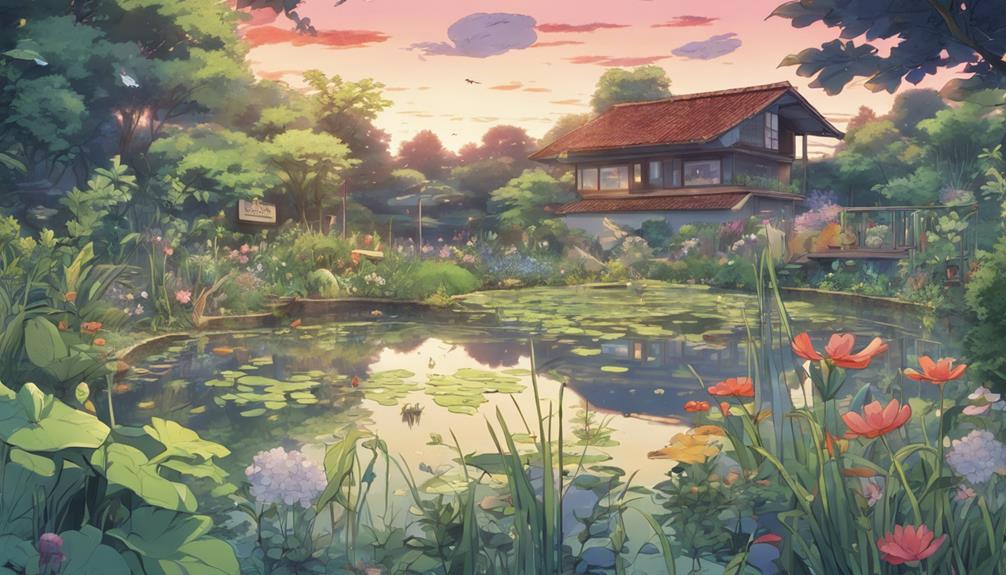
Frogs serve as invaluable allies in your garden, efficiently controlling pest populations by consuming a wide array of insects, including caterpillars, beetles, moths, and slugs, without causing harm to the plants.
These amphibians, including toads, act as natural pest control agents, greatly reducing the need for chemical pesticides. A single frog, like the American toad, can devour over 10,000 insects in a gardening season, showcasing their effectiveness as pest managers.
Incorporating elements that attract frogs, such as water features and plants around your garden, not only aids in pest control but also contributes to creating a balanced ecosystem.
Frogs are sensitive to chemicals; hence, their presence is a good indicator of a healthy, less polluted environment. This aspect is critical, as it aligns with the goals of gardeners who aim for ecological balance and prefer eco-friendly gardening practices.
Top Frogs for Pest Control
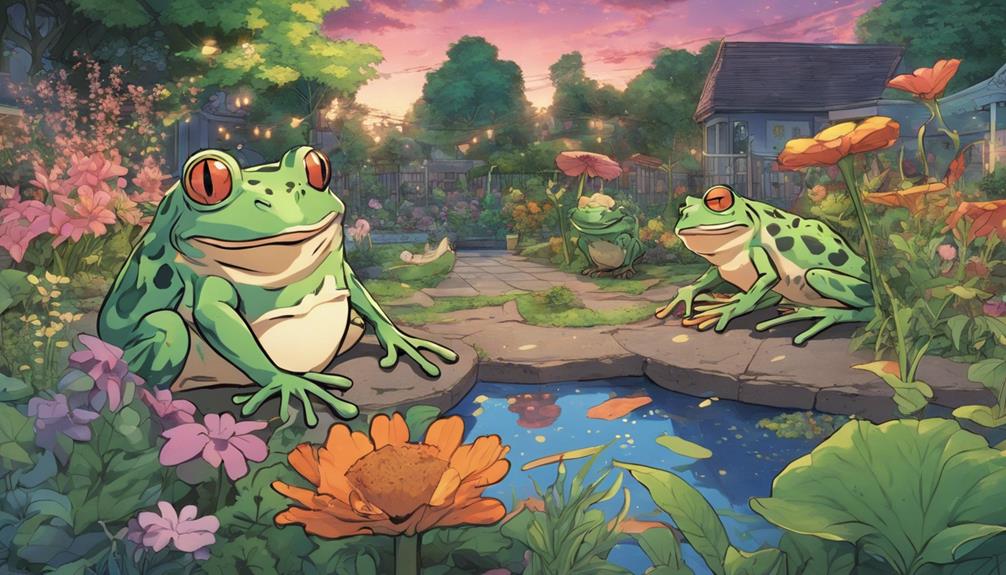
Understanding the specific types of frogs that excel in pest control can greatly enhance your garden’s health and ecological balance.
Frogs and toads need particular environments to thrive and, in turn, serve as a vital form of pest control. Among the top performers, American Green Tree Frogs stand out due to their efficient insect-hunting skills that target harmful garden pests.
Similarly, Bullfrogs, with their voracious appetite for insects, including mosquito larvae, are indispensable allies in maintaining pest populations at bay.
Leopard Frogs, adaptable and resilient, are another key species that contribute significantly to garden health by consuming a wide range of pests. Their presence promotes a reduction in the number of damaging insects, fostering a healthier garden ecosystem.
Pacific Tree Frogs, too, play a critical role due to their insect-eating habits, helping to balance the garden’s ecosystem naturally.
Cuban Tree Frogs, although not native to all regions, are effective in controlling insect populations where they’re established, marking them as a valuable asset for garden pest management.
These frogs eat a substantial number of pests, and their requirement for a water source, such as a small pond or even toad houses with places to hide, aligns with creating a conducive environment for their survival and pest control activities.
Creating a Frog-Friendly Habitat
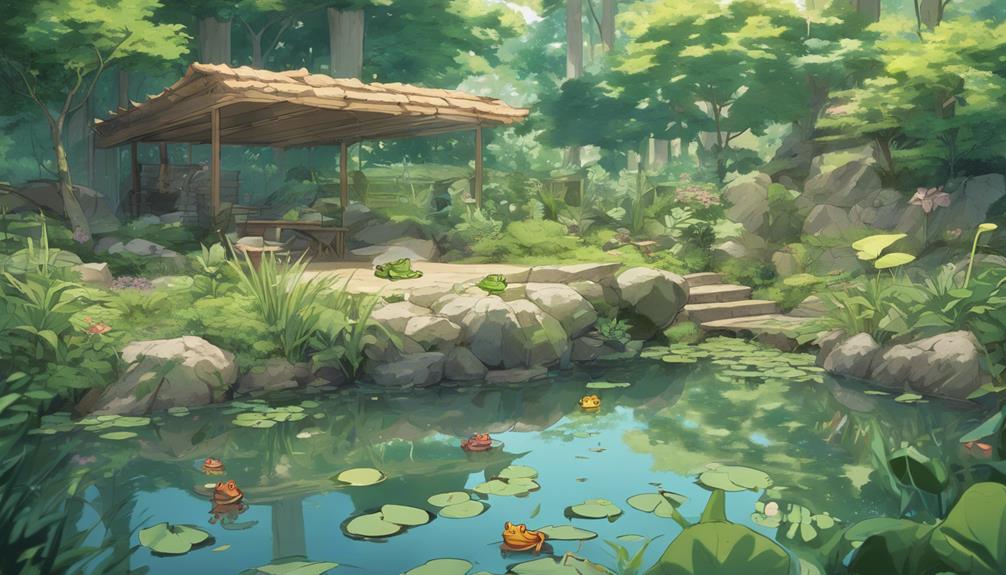
Creating an environment conducive to attracting and supporting frogs requires thoughtful consideration of water sources, shelter, and chemical-free spaces within your garden.
Implementing natural water sources like ponds or even shallow dishes can greatly enhance your garden’s appeal to frogs and toads seeking hydration and habitat. These water features not only serve as a magnet for these natural pest control agents but also enrich your garden’s biodiversity.
To further entice frogs to your garden, offering shelters such as overturned clay pots, strategically placed boards, or specifically designed frog houses near these water sources can make a big impact. These refuges offer frogs a secure place to hide from predators, rest, and reproduce, establishing a permanent population in your garden.
When creating a frog-friendly habitat maintaining a chemical-free environment is essential. Synthetic fertilizers and pesticides can harm frogs, disrupting their role in natural pest control.
Instead, focus on tailoring habitat modifications that cater to the specific preferences of frog and toad species known for their pest control capabilities. Incorporating native plants and ensuring a balanced ecosystem are vital steps in supporting a frog-friendly habitat. Such modifications not only benefit frogs but also enhance the overall health and appeal of your garden, creating a thriving community for you to enjoy.
Common Garden Pests Frogs Eat
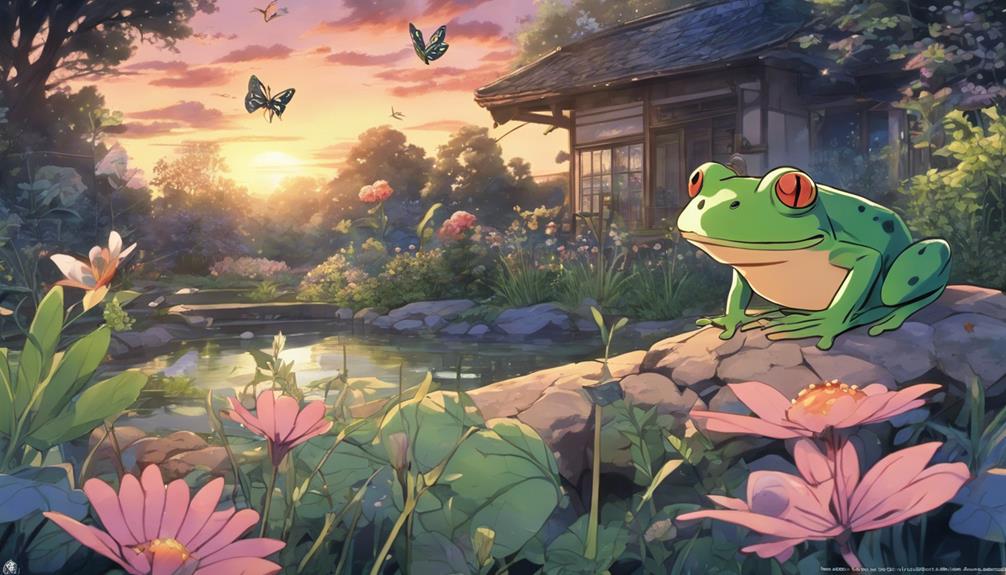
After establishing a frog-friendly habitat in your garden, it’s important to recognize the variety of common pests these amphibians help control. By attracting frogs, you’re enlisting a neat, safe, and natural pest control method.
Frogs, including the common toad, are voracious eaters, consuming garden nuisances like caterpillars, beetles, moths, and slugs. Their appetite is impressive, with a single frog capable of devouring over 10,000 insects in a gardening season. This fact underscores their role in pest population management, without harming your plants.
Creating a frog pond or ensuring a body of water is nearby, along with planting flowers and maintaining a moist environment, attracts these beneficial amphibians. Their permeable skin requires a moist habitat, making a well-designed garden an ideal place for frogs to thrive and reproduce, laying their eggs in water.
In various regions, specific frog species, including leopard frogs, gray tree frogs, and American toads, target different pests, providing tailored pest control. By integrating these natural predators, you’re not just protecting your garden; you’re participating in a sustainable, eco-friendly pest management strategy that enhances your sense of belonging to the natural world.
Maintaining a Balanced Ecosystem
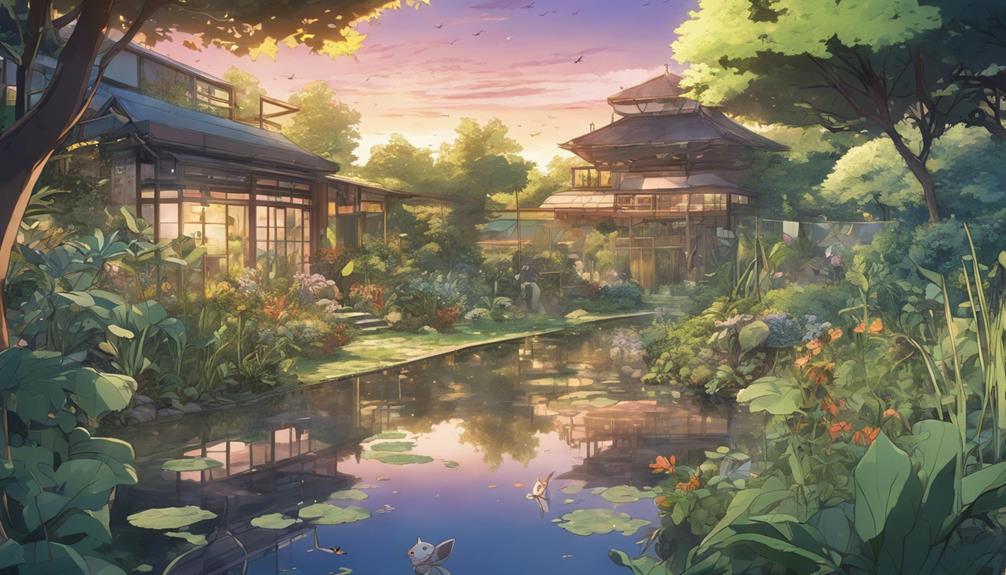
To maintain a balanced ecosystem in your garden, it’s vital to monitor frog populations to prevent overbreeding. Frogs, acting as a natural form of pest control, greatly reduce the need for pesticides and herbicides, keeping your garden safe for other wildlife and plants. However, their populations must be kept in check to avoid them becoming a nuisance or adversely affecting other species.
Educating yourself on regional frog needs and behaviors is important. This knowledge allows you to provide suitable habitats that not only attract frogs and toads to your garden but also help in preventing invasive species that could disrupt the ecosystem balance. For instance, knowing which types of ponds favor your local frog species over non-native ones can be incredibly beneficial.
Additionally, promoting a diverse ecosystem by providing food sources and habitats encourages the presence of other beneficial species, such as snakes, which keep frog populations in check. This delicate balance ensures that none of the species become overdominant, thereby preventing the need for chemical interventions.
Being proactive in preventing the introduction of non-native frog species and monitoring existing populations is key to maintaining this harmony and guaranteeing your garden remains a thriving, eco-friendly space.
Overall…
To sum up, incorporating frogs into your garden not only enhances pest control but also contributes to a balanced ecosystem. By selecting appropriate frog species and crafting habitats conducive to their survival, you’ll naturally mitigate common garden pests.
However, it’s critical to maintain this balance, ensuring that frog populations don’t outweigh the garden’s capacity to support them. Through careful planning and understanding of these amphibians’ ecological roles, you can achieve a healthier, more sustainable garden environment.
